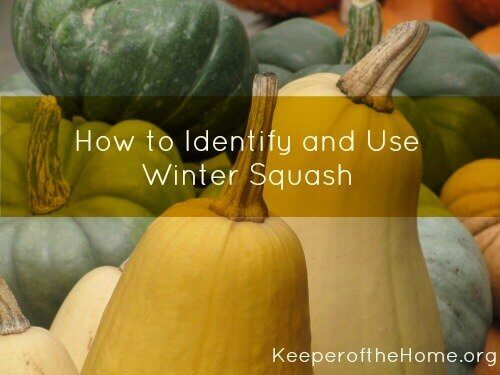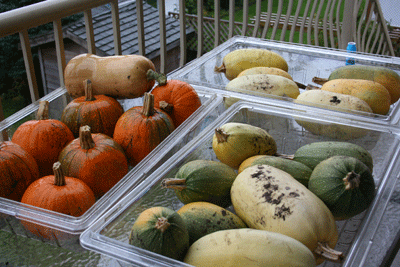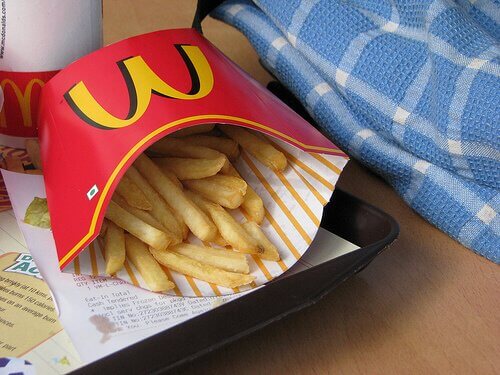How to Identify and Use Winter Squash
While most can identify pumpkin and butternut as varieties of winter squash, many of us don’t know much about other types of winter squash or how to prepare them. Today I want to dive into the world of winter squash and open the door to new eating possibilities.
Health Benefits of Winter Squash
Winter squash, especially those with darker flesh (like pumpkin and acorn) contain high amounts of carotene. Carotene has been shown to help protect against cancer, heart disease, and type-2 diabetes. (source)
Varieties of winter squash are also great sources of vitamin C, and B1, folic acid, potassium, and dietary fiber.

Types of Winter Squash:
The following is a list of the most commonly known (and used) winter squash. A more comprehensive list can be found here.
Acorn Squash
Acorn squash has skin that is dark green, orange, or a mixture of both. Acorn squash is not as sweet as other squash and has an almost nutty flavor.
I enjoy cutting in half, baking them in the oven and eating right out of the skin with butter, salt and pepper.
Acorn squash is also great for baking and stuffing with other ingredients. One half makes a good size serving portion for an adult.
Recipes to try:
Butternut Squash
Shaped like a large pear, butternut squash has cream-colored skin and orange-colored flesh. It has a sweet flavor and is delicious roasted or included in soups and stews.
Recipes to try:
- This butternut squash soup is excellent. Even my daughter, who doesn’t like squash, enjoyed it.
- My family also loves this butternut ravioli stew.
- butternut squash fries
- cinnamon maple butternut squash
Hubbard Squash
This larger sized squash can be grey or slate-colored, dark green, orange-red, or blue skinned. It has a non-stringy flesh that is less sweet than many other squash varieties and is actually one of the best for eating.
Recipes to try:
- mashed Hubbard squash
- roasted Hubbard squash soup with hazelnuts and chives

Banana Squash
The shape and skin color of this squash looks much like a very large banana. They are usually sold pre-cut into slabs since a whole banana squash can be two feet long and is a little large for the average home cook! Banana squash has a sweet flavor.
Recipes to try:
Pumpkin
Pumpkins are one of the most well-known winter squash. Usually orange in color, pumpkins come in a variety of sizes. Small sugar-pumpkins are the most flavorful.
Growing up in Australia, we always had roast pumpkin alongside our roast potatoes and baked chicken. Just peel and cut into chunks and add to roasting pan along with the chicken. I was so surprised when moving to the United States that no one seemed to eat pumpkin unless it was sweetened and made into a pie!
Recipes to try:
- grain-free pumpkin muffins
- pumpkin spice pancakes
- pumpkin pie casserole
- pumpkin walnut bread
- roasted pumpkin soup
- how to make your own pumpkin puree
- canning pumpkin
Spaghetti Squash
Oval in shape and yellow in color, spaghetti squash has a coarse flesh that can be pulled into long, spaghetti-like strands when cooked. Spaghetti squash is an excellent replacement for regular spaghetti if you are cutting down or eliminating grains or carbs.
To cook spaghetti squash: Preheat oven to 400 degrees F. Cut the stem from the squash and then slice squash in half lengthwise. Scoop out the seeds. Place squash halves, flesh-side down, in a baking dish. Bake for approximately 40 minutes or until squash shreds easily with a fork. Cool slightly, shred with forks and serve.
Spaghetti squash is great topped with marinara sauce or tossed with butter and cheese.
Recipes to try:
- Spicy Spaghetti Squash with Black Beans looks wonderful.
- spaghetti squash fritters
Selecting and Storing Squash
Choose squash that are firm and heavy for their size. The rind should be hard and dull in color (not glossy). Avoid squash that is soft or has moldy spots.
Store in a cool, dry place.
Squash can be stored from one to six months.
Methods of Preparing Squash
Baked Squash
This is the method I use most frequently (although I sometimes need my husband to cut the squash in half for me!)
Cut squash in half and scrape seeds out. Place in a baking tray, flesh side down.
Bake in a 350 degree oven until soft (usually 40 minutes or longer, depending on size).
Baked Whole Squash
Squash can be very difficult to cut; when this is true, baking whole is a great alternative.
To bake a whole squash, heat oven to 350 degrees and bake for 30 minutes or longer (until it feels soft when pressed).
Remove and cool slightly. Cut in half and remove seeds, then return to oven and continue cooking until done.
Roasted Squash
Preheat oven to 400 degrees F. Peel and seed squash and slice into 2-inch cubes. (It’s best to use squash that is easier to peel, such as butternut or banana squash). Toss squash in oil and sprinkle with salt and pepper. Spread on a large baking sheet and roast for 15 minutes. Turn the pieces and roast for a further 15 minutes. Turn once more and continue roasting until squash is to desired softness (about 10 minutes more).
Steamed Squash
Cut squash into large cubes and place into a steamer basket over boiling water. Steam, covered, for 30 to 40 minutes. It’s delicious served with butter, salt and pepper. Steamed squash can also be pureed or mashed and used in other dishes.
Squash Puree
Halve the squash and scrape out the seeds. Place both halves on a baking sheet, flesh side down, and bake at 375 degrees F for about 30 minutes, or until soft. Once cool enough to handle, scrape squash from the skin into a bowl. Mash and stir with a wooden spoon until smooth. You can also puree in a food processor or blender.
Store pureed squash in the freezer for use in soups, muffins, pies, and breads.
Does your family enjoy a specific variety of winter squash? What is your favorite way to prepare winter squash?







Great information! I actually posted about squash today too – shared my favorite method for roasting butternut! It’s a little sweet and a little savory – yum!!!
Spaghetti Squash is yummy in my tummy! 🙂
I am very unfamiliar with squash. I purchased a butternut and hoped I purchased the right one….as I knew nothing about it. I would like to see more pictures to go along with this article since the heading states “Identify” I only saw grouping of squash in these pictures. I would like to venture out and try different ones but I’ll have to do more research.
This link has pictures for all the different varieties: http://whatscookingamerica.net/squash.htm
What a great post. We love squash, but definitely tend to eat the ones I know how to prepare. Here is a recipe for Acorn Squash with Apple Stuffing by MaryJane Butters. It’s one of our all time favorites. Since it’s on the sweet side, we often have it for dessert. http://www.maryjanesfarm.org/recipe-project/recipe-20111010.asp
I read a tip the other day that suggested microwaving the squash for several minutes to help soften it up before cutting it. I haven’t had a chance to try it yet, but I thought I’d share that. Thanks for the great article!
My mom sometimes makes spaghetti noodles out of squash and puts the noodles in a spaghetti bake. Squash and regular spaghetti noodles have quite different textures, but covered in meat, cheese, and tomato sauce you can hardly tell a difference taste-wise.
I like the idea of making a spaghetti bake with spaghetti squash. You’re right, the meat, cheese and sauce make it hard to tell the difference.
You forgot about my favorite! Delicata squash is long and creamy white with green or yellow stripes. It doesn’t last as long in storage as most of the others, but it’s so good that it’s OK! The skin is much thinner than most other winter squash and can be eaten along with the flesh. Because of this, it’s easy to cut in half, clean and then slice up for pan cooking. It’s flavor is very delicate but pairs wonderfully with just about any flavor combo you want to try! 🙂
I have never tried Delicata squash but did see it mentioned quite a few times when researching for this article. Now I’m going to have to buy some!
Spaghetti squash is dryer with longer “noodles” if you cut it in rings instead of lengthwise.
We love squash! My daughter and I often eat spaghetti squash while the rest of the family has the wheat noodles. It makes wonderful lasagna!
We have found it easier to prepare when we wash the outside, cut it in half lengthwise, scoop out the seeds and submerge it in boiling water for 20-30 minutes, just until the outside gives when you push it with the back of a spoon. Then, if you let it sit open-side-up to cool, it allows the cooking to cease before it gets too mushy. We do this in the morning and by dinner time, the “noodles” come out very easily. If you don’t want to waste the water-soluble vitamins that you fear may be lost in the cooking water, you can pop some bones in after removing the squash, using the water to start your broth.
Thank you for all the wonderful suggestions and recipes! I have a gigantic butternut squash which I am hoping to turn into delicious soup!
Great idea about using the squash water to make broth! Thanks for sharing.
Great article! I must admit I was surprised when you mentioned you grew up here as I don’t know anyone who calls a butternut a squash, it just comes under the rather uninformative ‘pumpkin’ category. I remember being surprised a few years ago when I started seeing ‘butternut squash’ on American blogs and realising we call it the wrong thing! I’ve been using butternuts in sweet recipes of late as I’ve discovered they are quite yummy as a dessert, but roasted or in soup with a big dollop of cream is still my fav!
When I visited in Australia for two months, I had pumpkin twice along with roast and potatoes. It was delicious! I also had pumpkin soup (along with rolls and Vegemite 🙂 ). I thought it was funny that they thought “pumpkin pie” was funny! When I explained that most American pumpkins weren’t really designed for eating (think jack-o-lantern pumpkins), they understood a bit more.
Thanks for this comprehensive post about the different types of squash–wish I could get hubby on board with winter squash! Maybe one of these years 🙂
Got to love the Vegemite! Glad you got to experience some roast pumpkin in the land down under!
We love winter squash in our home! Well, I also love winter, so the two go together well for me. Butternut, Acorn and of course Spaghetti Squash are our favourites. I love making Butternut or Acorn squash soup (we usually add some Champagne for a yummy flavour!). Spaghetti squash with butter and salt is one of my favourites. Almost as yummy as corn on the cob.
my friend needs this blog post! She was lamenting not being able to figure out the differences the other day
My favorite is Delicata squash, too, Diana! 🙂 It keeps for me on the shelves of my garage for weeks after harvest! My husband will eat it, and my teens especially love it made into “squash fries”, either roasted or deep-fried. (They’ll even help make them! another yea!) The other important thing to remember for us gardeners is that squash seeds can usually be kept (after washing and drying) to plant next spring, saving even more money! And if you don’t have any room or desire to plant, the seeds can be washed & dried, boiled &/or roasted and eaten, too!
Thanks for sharing. I’m going to pin this to reference since I have several winter squash from my cropshare. I would love if you would post this and some of your other posts on my Eco Kids link up: http://organicaspirations.blogspot.com/2012/11/eco-kids-link-up.html
Glad I’m not the only one who needs my husband to cut squash 😉 Thanks for the informative post!
I just wanted to let you know this post prompted me to buy an acorn squash tonight! 🙂